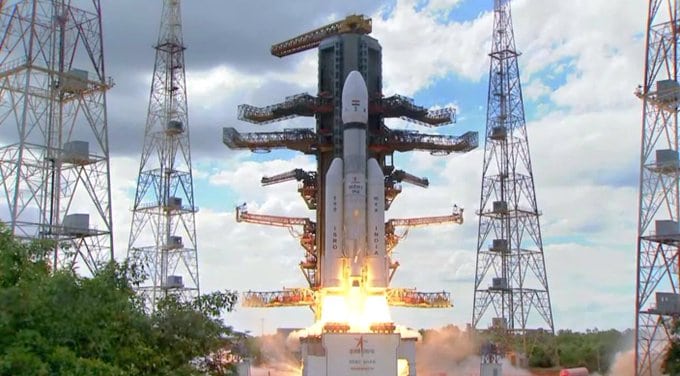The recent successes of Chandrayaan-3 and Aditya are no mere coincidences.
They are the culmination of decades of meticulous planning, groundbreaking technological advancements, and the unwavering dedication of thousands of scientists and engineers.
These missions, painstakingly guided from the bustling hub of the Master Control Room in Bengaluru, showcase India’s mastery in navigating spacecraft millions of kilometres away, a feat that has left even established spacefaring nations like the US and Russia in awe.
India’s space program stands as a testament to the nation’s unwavering spirit of innovation and ambition.
From the flawless lunar landing of Chandrayaan-3 to the pioneering solar mission Aditya, ISRO has consistently pushed the boundaries of scientific exploration, etching its name in the annals of global spacefaring nations.
Images of scientists transporting sounding rockets on bicycle carriers and the iconic APPLE satellite being transported on a bullock cart paint a vivid picture of the resourcefulness and determination that fuelled India’s early space endeavours.
The surge in public interest towards India’s space endeavours is palpable.
Launch events at the Satish Dhawan Space Centre have become national spectacles, rivalling the excitement of a cricket match between India and Pakistan.
Witnessing the final countdown unfold from a distance of six kilometres, the anticipation hanging heavy in the air, transcends technical complexities and ignites a deep sense of pride in every Indian heart.
The impact of ISRO’s efforts extends far beyond the realm of scientific exploration.
From enabling seamless mobile phone communication and Direct-To-Home (DTH) television to providing critical weather forecasts that save lives, ISRO’s constellation of communication and remote sensing satellites touches every facet of daily life in India.
This is a realization of Vikram Sarabhai’s vision, who saw space technology as a tool to elevate the lives of every Indian, particularly those in need.
Unlike other spacefaring nations driven by Cold War-era ambitions, India’s space program has always been guided by a unique philosophy.
Somanath, a strong advocate for satellite communication accessibility, champions affordability and urges innovative solutions to deliver ground infrastructure and connectivity at ultra-low costs to millions.
While the US and the USSR saw launch vehicles as mere extensions of ballistic missile technology, Sarabhai prioritized applications first, with satellites and launch vehicles following suit.
This is evident in initiatives like SITE (Satellite Instructional Television Programme), which leveraged transponders from a US satellite to deliver education via television to millions across India.
The journey hasn’t been without its share of hardships.
Images of scientists transporting sounding rockets on bicycle carriers and the iconic APPLE satellite being transported on a bullock cart paint a vivid picture of the resourcefulness and determination that fuelled India’s early space endeavours.
Developing launch vehicles, particularly the PSLV and GSLV, proved to be a formidable challenge, further compounded by external attempts to derail the programme.
Despite limited resources, the Indian Space Research Organisation (ISRO) has carved its place among the world’s leading space agencies, even shaking up established norms.
Missions like Mangalyaan and Chandrayaan, completed at a fraction of the cost of Hollywood blockbusters, exemplify ISRO’s remarkable efficiency.
This frugality can be traced back to the agency’s humble beginnings. Just as iconic tech giants like Apple and Microsoft started in garages, ISRO originated from a small lab established by Vikram Sarabhai, often called the “father of India’s space program.”
This legacy of resourcefulness, since its formal establishment in 1969, has fuelled ISRO’s rise to prominence in the global space arena.
Five decades since its inception, the Indian Space Research Organisation (ISRO) is undergoing a dynamic transformation.
It has transitioned from a pioneer to a catalyst, fostering India’s burgeoning spacetech ecosystem.
Years of meticulous incubation and nurturing have paid off, propelling the sector to critical mass.
Over 400 companies now stand poised to conquer new frontiers in fields like launch services, satellite communications, and even space tourism.
Remarkably, this remarkable growth has been achieved with the same characteristic Indian virtues of thrift and pragmatism.
Perfecting this heavy-lift launch vehicle is essential for deploying communication satellites in geostationary orbit, paving the way for advancements like direct satellite phone connectivity and eliminating call drops.
This commitment to cost-effectiveness and practicality was recently reiterated by ISRO Chairman S. Somanath at the Indian Space Congress, highlighting the agency’s dedication to building a sustainable and robust spacetech ecosystem for India.
Somanath, a strong advocate for satellite communication accessibility, champions affordability and urges innovative solutions to deliver ground infrastructure and connectivity at ultra-low costs to millions.
This is particularly crucial considering the projected boom in the satellite internet market.
A Deloitte study forecasts its share of the global space industry to skyrocket from a mere 1% currently to a remarkable 27% by 2040.
Additionally, other areas like satellite manufacturing, launch, commercial human spaceflight, and remote sensing are also poised for significant growth.
Notably, the study predicts a decline in government spending, from 27% in 2021 to less than 18% by 2040, indicating a shift towards the private sector as the primary driver of future expansion.
This emphasizes the need for a robust Indian private space industry to capitalize on the immense potential of the burgeoning satellite market.
Although it is often celebrated as the world’s most cost-effective space agency, ISRO has historically operated with a public service mentality rather than a strictly commercial one.
Revenue from satellite launches, for example, previously flowed to the Department of Space (DoS) to fund further programs.
However, the 2019 creation of NewSpace India Ltd. (NSIL) marked a shift, with NSIL now handling commercial activities and profits returning to the DoS, ultimately funding ISRO.
This opening of the Indian space sector to private participation is being actively driven by ISRO, aiming to transform the model from supply-based to demand-driven.
Through technology development, transfers, and facility sharing with NSIL and private entities, ISRO is fostering capacity building.
It is working hard to maintain India’s edge as a low-cost, reliable launch provider through the upcoming Small Satellite Launch Vehicle (SSLV) and a reusable rocket program.
India’s space program has come a long way in nearly six decades, transforming from dependence on foreign launch vehicles to self-reliance. India now not only launches own satellites but also offers launch services to other nations, having successfully placed 424 foreign satellites in orbit.
Recognizing the competitive landscape where even global giants like SpaceX are driving down costs, ISRO sees urgency in its efforts.
The SSLV, designed for small satellite constellations, will be available for industry production and operation, with 23 companies already expressing interest.
Similarly, ISRO is looking for private partnership to accelerate its reusable rocket program, recognizing the need for business ownership and scalability to compete effectively.
While India has tasted success with the GSLV, further refinement is crucial.
Perfecting this heavy-lift launch vehicle is essential for deploying communication satellites in geostationary orbit, paving the way for advancements like direct satellite phone connectivity and eliminating call drops.
Additionally, ISRO’s expertise can be harnessed to revitalize dormant landline connections and bridge the digital divide.
It is now imperative to prioritize pressing needs like telemedicine and satellite-based education.
Bringing healthcare to remote areas and democratizing access to quality education through satellite internet should be at the forefront of ISRO’s agenda.
Indigenization of critical components has been key to this cost-effectiveness, inspiring discussions in the international community.
Moreover, collaborating with All India Radio to utilize its network of FM stations for a 24×7 national broadcast channel would rekindle public interest in radio and provide a platform for diverse programming.
India’s space program has come a long way in nearly six decades, transforming from dependence on foreign launch vehicles to self-reliance. India now not only launches own satellites but also offers launch services to other nations, having successfully placed 424 foreign satellites in orbit.
Countries like the USA, UK, and Singapore are some of the major beneficiaries of this international cooperation.
Beyond serving domestic needs through communication infrastructure, weather forecasting, and remote sensing, ISRO has set its sights on ambitious deep space missions.
The recent Chandrayaan-3 landing marks India as only the fourth nation to touch the moon, and the first in the South Polar region.
This success, a testament to ISRO’s ability to learn from setbacks (like Chandrayaan-2), has earned us a place in the Artemis Accords for lunar exploration.
Mangalyaan, India’s maiden Mars mission, placed it among the select few nations to reach the Red Planet, showcasing exceptional cost-effectiveness.
Similarly, the Aditya L1 mission promises new insights into the Sun from a unique vantage point, solidifying India’s position in solar research.
What truly sets ISRO apart is its ability to achieve these feats at a fraction of the cost compared to major space agencies.
Indigenization of critical components has been key to this cost-effectiveness, inspiring discussions in the international community.
Furthermore, the 2023 Space Policy welcomes private enterprises to join this thrilling saga, leveraging their innovation and entrepreneurial spirit to propel India’s space ambitions even further.
(Writer, Dr. Maheep, is an eminent scholar of International Relations and Global Politics. He contributes regularly to the contemporary issues of utmost importance)









Comment